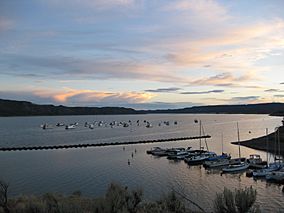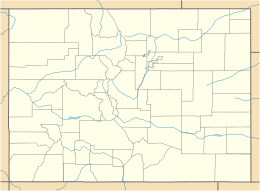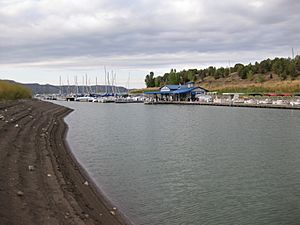Navajo State Park facts for kids
Quick facts for kids Navajo State Park |
|
|---|---|

Navajo Lake at sunset from Rosa Campground
|
|
| Location | Archuleta / La Plata counties, Colorado, United States |
| Nearest city | Arboles, Colorado |
| Area | 5,087 acres (2,059 ha) |
| Established | 1964 |
| Governing body | Colorado Parks and Wildlife |
Navajo State Park is a beautiful state park in Colorado, USA. It sits on the north side of Navajo Lake. This huge lake is like Colorado's own Lake Powell! It's a large reservoir on the San Juan River.
The San Juan River starts in Colorado's San Juan Mountains. The lake stretches about 20 miles (32 km) into New Mexico. The park covers about 15,000 acres (6,070 ha). It has 150 miles (241 km) of shoreline across two states. People love to visit for boating, houseboating, fishing, and camping. You can also see lots of wildlife here. There's even another state park in New Mexico at the lake's southern end.
Contents
Park History: From Ancient Times to Today
The land where Navajo State Park is now was once home to the Ancestral Puebloans. These early people left the area around 1050 A.D. This was likely because of a serious drought. Later, the Ute and Navajo tribes settled here in the 1300s.
Early Explorers and Railroads
In the late 1700s, the Dominguez–Escalante Expedition explored this region. These ten explorers were some of the first Europeans to enter the area. Their goal was to find a route from New Mexico to California for the Spanish.
In the early 1880s, the Denver and Rio Grande Western Railroad built tracks here. The railroad was very important for the local economy. It served the area until 1967.
The Navajo Dam was built in 1962. Its main purpose was to provide water for farming. This water helped the Navajo Nation grow crops. The dam created Navajo Lake, which is now a popular spot for visitors.
Navajo State Park is a great place to see many different animals. Both migratory birds and birds that live here all year can be found.
Birds and Mammals
You might spot several types of raptors, like eagles or hawks. Other common birds include pinyon jays, black-billed magpies, and common ravens. The lake also attracts many waterfowl and shorebirds.
On land, you'll often see mule deer. Smaller animals like cottontail rabbits, coyotes, red foxes, porcupines, and striped skunks are also common. Ground squirrels are busy residents too.
Some rare animals live here as well. River otters have been brought back to the Piedra River. You might also see bald eagles and white pelicans in the summer.
The lake offers great fishing for both warm-water and cold-water fish. Anglers can catch largemouth and smallmouth bass. Other popular fish include crappie, bluegill, catfish, and northern pike. For cold-water fishing, there are rainbow trout and kokanee salmon.
Plants and Trees
The park's higher lands have different plant communities. You'll find pinyon-juniper woodlands, sagebrush shrublands, and western slope grasslands.
Pinyon-Juniper Woodlands
These areas have short pinyon pine and Utah juniper trees. Underneath them are shrubs and grasses. These woodlands grow on dry slopes, hills, and mesa tops. Common plants here include Gambel oak, big sagebrush, and various grasses.
Sagebrush Shrublands
This plant community has lots of big sagebrush, rabbitbrush, and Gambel oak. It grows on slopes that get more moisture. It also forms the understory for the pinyon-juniper areas.
Western Slope Grasslands
These grasslands have grasses that form a thick mat, like blue grama and western wheatgrass. You'll also see bunchgrasses such as Indian ricegrass.
Wetland and River Plants
Around the reservoir and along the San Juan and Piedra rivers, you'll find wetland plants. These plants grow in wet areas and near water.
Navajo State Park is known for its large reservoir. This 15,000-acre lake was formed in the San Juan River Valley. The Piedra River joins the San Juan River near the park's northern edge.
Mesas and Canyons
The higher parts of the park have flat-topped mesas and gently rolling hills. Sometimes, these hills are cut by steep-sided canyons.
Rocks and Deposits
The rocks in the uplands are sedimentary rocks. They formed during the Eocene epoch, which was a long time ago. These rocks include sandstones and conglomerates. Along both rivers, you'll find more recent deposits. These include alluvium (river deposits), terrace gravels, and alluvial fan deposits.
See also
 In Spanish: Parque estatal Navajo para niños
In Spanish: Parque estatal Navajo para niños



